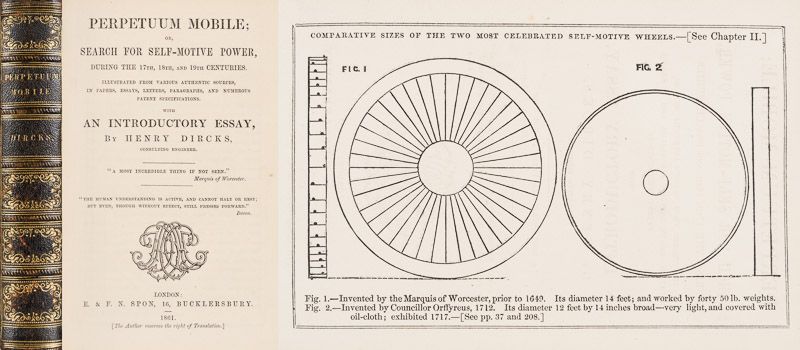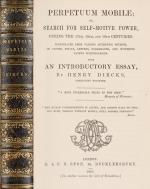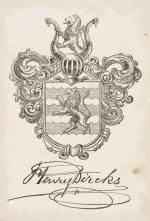Dircks, Perpetuum Mobile; or, a History of the Search for Self-Motive Power, fro
Perpetuum Mobile; or, a History of the Search for Self-Motive Power, from the 13th to the 19th Century [Author’s own copy]. Illustrated from various authentic Sources, in Papers, Essays, Letters, Paragraphs, and numerous Patent Specifications.
First Edition. London, E. & F.N. Spon, 1861. Small Octavo. Frontispiece, XLI, 558 pages. Hardcover / Full leather with gilt lettering and rich ornament on spine and boards. All edges gilt. The author’s own copy with his bookplate to the pastedown. Henry Dircks must have given his special bound “author’s copy” away because the endpaper bears his inscription to Dr. John Waggett MD FRCS (1818-1909), London’s beloved General Practicioner, Vaccinator and Honorary Surgeon to the local dispensary for the poor: “Dr.Waggett – With the author’s compliments – May 1862”. Excellent condition with only very minor signs of external wear.
Includes the following chapters: Mathematics opposed to perpetual motion / Perpetual Motion defined / Inventions of the Marquis of Worcester and Councillor Orffyreus / Patents of the Seventeenth and Eighteenth Century / Early Papers from the Philosophical Transactions and Sir Robert Boyle – also the Paris Academy of Sciences with Notices of Communications to the Academy (1837-1856) / Remarks on Perpetual Motion derived from treatises on Natural Philosophy / Papers from Early Scientific and other Journals / With an Appendix: From “Theatrum Machinarum Generale” by Jacob Leupold / From John Bernoulli’s works, 1742 / List of Belgian Patents 1854 to 1857 / Fictitious perpetual motions at the Polytechnic Institution / Professor Airy on certain conditions under which Perpetual Motion is possible //
Henry Dircks FRSE FCS (26 August 1806 – 17 September 1873) was an English engineer who is considered to have been the main designer of the projection technique known as Pepper’s ghost in 1858. It is named after John Henry Pepper who implemented a working version of the device in 1862. Dircks also investigated attempts at the invention of a perpetual motion device, writing that those who sought to create such a thing were “half-learned” or “totally ignorant”. Dircks was born in Liverpool on 26 August 1806.
He was apprenticed to a mercantile firm and spent much of his free time studying practical mechanics, chemistry, and literature. Around the mid-1820s he began lecturing about chemistry and electricity while writing literary articles in the local press and scientific papers in the Mechanics’ Magazine and other journals. In 1837 he became a life member of the British Association, and afterwards contributed papers to its proceedings. Two years later he wrote a pamphlet regarding a proposed union of mechanics’ and literary institutions. He also wrote a short treatise entitled “Popular Education, a series of Papers on the Nature, Objects, and Advantages of Mechanics’ Institutions”, first printed in Liverpool in 1840.
He became a practical engineer, conducting railway, canal, and mining works, before progressing to the role of consulting engineer. He continued to investigate technologies and invent new devices, taking out several patents between 1840 and 1857. Dircks joined the Royal Society of Literature, the Royal Society of Edinburgh, and other scientific bodies. In 1867 he was elected a full Fellow of the Royal Society of Edinburgh, his proposer being William John McQuorn Rankine. In 1868 he was given an honorary degree (LL.D.) from Tusculum College in Tennessee. Dircks died in Brighton on 17 September 1873. (Wikipedia)
- Keywords: author’s own copy · Catalogue Nine – Medicine · Catalogue No.9 – Medicine · Engineering – Rare · Inscribed · Pepper’s ghost · Perpetual Motion · Science – Rare · Technology – Rare · Technology & Engineering – Rare · WCBF Highlight
- Language: English
- Inventory Number: 28452AB
EUR 780,--
© 2025 Inanna Rare Books Ltd. | Powered by HESCOM-Software
















